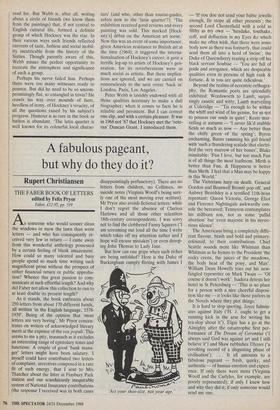A happy medium
Richard Shone
PORTRAIT OF DAVID HOCKNEY by Peter Webb
Chatto & Windus, £17.95, pp.289
Bernard Levin, whose all too frequent pronouncements on the visual arts are infallibly, even reassuringly wrong, calls David Hockney a 'genius', adding that he is 'surely the greatest of living English artists'. This was in 1980 when Nicholson and Moore were alive and working. A partial corrective to Levin's hyperbole is offered by Peter Webb's biography, the Tate Gallery's current retrospective and a galaxy of sideshows and spin-off publica- tions. For those long wearied with Hock- ney's name there is the easy temptation to knock his reputation over the boundary into the grazing lands of popular entertain- ment. At another extreme there are those
who, though not unknowledgeable, praise him excessively, confusing personality and performance, popularity and paint. For the majority, however, Hockney is the accept- able face of contemporary art. His work is attractive, not too daring and yet suffi- ciently intelligent to occupy a healing role between the obviously traditional and the intractably modern. He is accessible with- out being bland, singular without being a crank. In this sense he is similar to Betje- man. Both figures, in their public personae as well as in their work, have qualities in common. They have a seemingly effortless ability to communicate, technical virtuos- ity, a begniling Mixture of the then and the now and a disarmingly frank line in auto- biographical chat which in fact keeps a good deal hidden. Like Betjeman, Hock- ney's charming public character and his ability to say things simply and personally overshadow a complex, uneven artist.
Hockney's astonishing fame indicates the existence of at least two different though overlapping audiences for contem- porary art, with standards of their own. On the one hand, there is relatively little first-class critical writing on his work (Mar- co Livingstone's updated study remains authoritative) and his influence in the art schools has been almost extinct for some time — unlike that of Freud, Auerbach or Long, for example. On the other hand, Hockney obviously fills a need, though whether as artist or man it is difficult to
gauge. In spite of the Sun's declaration, in reference to Hockney's condemnation of ClaiiSe 28, that 'We can get along without his paintings', the queues at the Tate (over 50,000 visitors in the first three weeks) seem to suggest otherwise. His undisturb- ing vision of the world is obviously to their taste. That a few of the paintings and more of the prints and illustrations will survive seems certain; what kind of life they will lead is less so. As brilliant inhabitants of the outhouse of 20th-century art? As soph- isticated social documents a la Jacques- Emile Blanche? As the work of a brilliant printmaker and photographer who also happened to paint?
Peter Webb only addresses such ques- tions at the very end of his book. No follower of Levin, he nevertheless leaves it to the future to show whether or not Hockney is a 'great artist'. As we know, the future is given too much credit for such distinctions. Why not venture an opinion now? But Webb is not of a speculative turn of mind and has written his biography with
Gradgrindian attention to the facts. Such an approach is usually welcome but the facts in this case are not really very interesting and those that are have been generally known for years. Webb re- assembles them all with the kiss of death. Naturally the author has been inhibited by the choice of a subject still very much alive, and undoubtedly the book was read for libel — perhaps the only thing it can be read for. But Webb is, after all, writing about a circle of friends (we know them from the paintings) that, if not central to English cultural life, formed a definite group of which Hockney was the star. In their various ways such friends reflected currents of taste, fashion and social mobil- ity inextricable from the history of the Sixties. Though patently aware of this. Webb misses the perfect opportunity to recreate the atmosphere and significance of such a group.
Perhaps his nerve failed him. Perhaps there were too many witnesses ready to pounce. But did he need to be so uncom- promisingly flat, so entangled in trivia? He crawls his way over mounds of facts, heedless of irony, of Hockney's vivacity, of all the questions raised by his subject's progress. Humour is as rare in the book as bathos is abundant. 'The latin quarter is well known for its colourful local charac- ters' (and who, other than tourist-guides, refers now to the latin quarter'?). 'The exhibition received good reviews and every painting was sold. This marked [Hock- ney's] debut on the American art scene.' Now this was an event of some importance, given American resistance to British art at the time (1964); it triggered the interna- tionalisation of Hockney's career; it gave a terrific leg-up to artists of Hockney's gen- eration, for its reverberations were as much social as artistic. But these implica- tions are ignored, and we are carried on remorselessly to the next event 'back in' London, Paris, Los Angeles.
Peter Webb is lavishly endowed with all those qualities necessary to make a dull biographer; when it comes to facts he is reliable and persistent. But I can correct one slip, and with a certain pleasure. It was in 1968 not '67 that Hockney met the 'vete- ran' Duncan Grant. I introduced them.











































































































 Previous page
Previous page